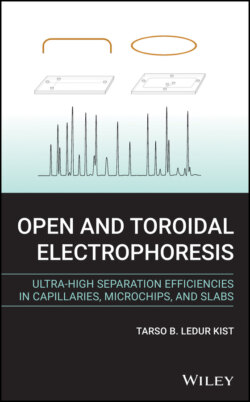Читать книгу Open and Toroidal Electrophoresis - Tarso B. Ledur Kist - Страница 24
1.1.12 Buffer Capacity
ОглавлениеThe buffer capacity () of a buffer solution is a measurable quantity and is defined as:
(1.19)
is defined as the derivative of the amount of equivalents (of a strong acid or base) to the pH. The unit of is the amount of equivalents that must be added to one liter of a buffer solution in order to change pH by one unit. Buffer solutions with high buffer capacities are always desired. In the laboratory is measured by titration and observing the amount of equivalents () of a strong base (or acid) that must be added to one liter of a buffer solution with an initial pH of , in order to increase (or decrease) its pH from to . This permits the definition of (depending on the sensitivity and precision of the pH-meter used). At this point the titration is paused and the buffer capacity of the solution at is calculated as follows: . Following this the titration is continued until the pH is changed by another increment of . is then calculated as , and so on. Plotting the values of a buffer against pH gives nothing more than a density probability distribution.
Figure 1.6 Buffer capacity of 0.1 M acetic acid (p) in an aqueous solution in the 1 to 13 pH range.
Equation 1.19(b), which is the integral form of equation 1.19(a), shows the number of equivalents of a strong base (or a strong acid) required to change the pH of one liter of a buffer solution from to (or the reverse). This integral represents the area under the curves between and .
For practical applications, buffer capacity can be predicted using equation 1.19 (a) and the definition of acid ionization constant (equation 1.15). The result is the following equation:
(1.20)
where (at 25 C), , and is the initial activity of the weak acid used to prepare the buffer solution. For instance, if 0.1 mol of acetic acid is used to prepare one liter then if . The same equation can be applied to a weak base (B), however in this case represents the initial activity of the weak base used.
Figure 1.6 shows the buffer capacity that should be expected when 0.1 mol of acetic acid is diluted in water to make 1 L solution. This gives a 0.1 M solution and note the high buffer capacity around pH = 4.75, which is the p of acetic acid. Figure 1.7 shows the same for a 0.1 M solution of Tris.
If a buffer is prepared by a mixture of weak acids and a strong base (or a mixture of weak bases and a strong acid), then the buffer capacity can still be predicted for each pH as follows:
(1.21)
Figure 1.7 Buffer capacity of 0.1 M Tris (p) in an aqueous solution.
Figure 1.8 Buffer capacity of 0.1 M -alanine (p and 9.6) in an aqueous solution. The buffer capacity at the isoelectric point () is low.
In this case the index refers to each weak acid (or weak base) or each functional group if the same molecule carries weak acid groups and weak basic groups. Figures 1.8 and 1.9 were plotted using this equation.
Figure 1.8 shows the buffer capacity of a 0.1 M solution of -alanine as a function of pH and Figure 1.9 for a 0.1 M glycyl-aspartic acid. Note that both -alanine and glycyl-aspartic acid do have isoelectric points (IEP), however only glycyl-aspartic acid has a good buffer capacity around its or close to the pH(I). A high buffer capacity at or close to the pH(I) is a highly desired property in the ESTs, as it allows the pH to be stabilized with minimal increase in the conductivity.
The total conductivity of the buffer must be higher than or close to the conductivity of the sample, otherwise it causes band destacking (Section 2.14). On the other hand, the lower the conductivity of the buffering electrolyte to the total conductivity of the buffer solution the better, as some room is left for the addition of some electrolytes with the same mobility as the analytes. This is important for the production of symmetric peaks in most of the separation modes. Isotachophoresis and isoelectric focusing are exceptions to this rule as they are based on special separation mechanisms. Some samples do have low conductivities, in this case the development of buffer solutions with low conductivity, i.e. designed for high field strengths operations, is always an active topic of research, [12] as they lead to high separation efficiencies (Section 3.5).
Figure 1.9 Buffer capacity of 0.1 M glycyl-aspartic acid (p, 4.45 and 8.6) in an aqueous solution. Note the high buffer capacity at .
Another very useful concept is the normalized buffering capacity/conductivity ratio.[13] Here, the buffering capacity at each pH is divided by the buffer conductivity at this pH. A high buffer capacity and low buffer conductivity are highly desirable. This allows different buffers to be compared among themselves at different pHs. Such performance rankings of good buffers are still missing in the literature.
